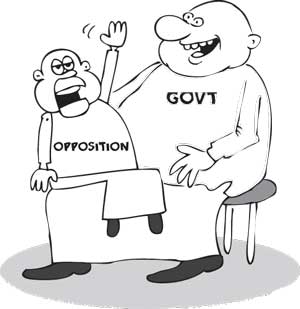Reply To:
Name - Reply Comment
One of the biggest problems that have plagued democracy in Sri Lanka according to many political commentators is the lack of a credible opposition. The 1978 Constitution while giving exceeding and dictatorial powers to the President when taken in totality made a weak opposition inevitable. The current Prime Minister and long-serving former Opposition Leader, Ranil Wickremesinghe was perhaps unfairly criticized for being ineffective when in fact his position was a product of a system he did not have the power to change.

In theory, the weakness of the present Opposition could be attributed to the same conditions that showed off Wickremesinghe in poor light all these years. However, in this particular Parliament at this point of time the term ‘The Opposition’ is in crises that have very little to do with JR Jayewardene’s insidious machinations.
Nimal Siripala Silva is the official ‘Leader of the Opposition’. Members of his party (SLFP) are part of the Cabinet. The cabinet is led by the Prime Minister who is the leader of the UNP. The leader of the party that Silva belongs to is President Maithripala Sirisena. Sirisena was chosen by the people of Sri Lanka to LEAD the country. By quite a margin, one might add. Silva claims that letting some party members join the Cabinet was to ‘strengthen the hand of the President’. Since the President and the Premier are in a hand-in-hand arrangement, one could go along with this contention. But what does this do to Silva’s own credentials to be the Opposition Leader?
Silva says that the SLFPers outside the Cabinet will provide (constructive?) criticism, as would be required of any respectable Opposition. However, if the President is the head of the SLFP how can Silva criticize anything done by a Cabinet of Ministers whose every decision has the President’s blessings?
It is in this context that post-election moves to ‘bring back’ Mahinda Rajapaksa have to be viewed. In a sense, it can be argued cogently that his key backers need him back to secure some kind of political future for themselves. At the same time it cannot be disputed that the ex-President still has a lot of play in the extra-parliamentary political equation outside of the fact that some 20 odd sitting MPs attended the last ‘Mahinda Rally’ in Ratnapura.
There is a danger here. The last time we had an extra-parliamentary player of any standing was when Prabhakaran in effect ruled the country for more than two decades. The man probably never stepped into Colombo during that time but all policy-decisions were framed in relation to the activities of the organization he led, the LTTE. A smaller version of this was witnessed in 1988-89 when the JVP’s punchi aanduwa held sway.
While it is silly at this point to compare the ‘Mahinda Rush’ (Mahinda Fever?) with Prabhakaran and Wijeweera, it must be mentioned that democracy never benefits when the most vocal sections of the Opposition is resident outside Parliament. On the one hand it gives the Government a free hand to do as it pleases and on the other objection has little or no representation within Parliament.
Elections (with or without promised reforms) may correct this ungainly and dangerous situation but this (natural?) outcome of bipartisanship, especially at a time when there are no serious external or internal threats to political stability does not bode well for democracy. All that can be said while the SLFP flounders in an identity crisis and thereby makes Silva’s role in Parliament meaningless and even laughable, opposition will gather force outside. For now ‘Mahinda Rajapaksa’ is a credible rallying point, whether we like it or not.